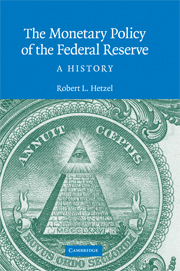Book contents
- Frontmatter
- Contents
- Figures
- Preface
- 1 The Pragmatic Evolution of the Monetary Standard
- 2 Learning and Policy Ambiguity
- 3 From Gold to Fiat Money
- 4 From World War II to the Accord
- 5 Martin and Lean-against-the-Wind
- 6 Inflation Is a Nonmonetary Phenomenon
- 7 The Start of the Great Inflation
- 8 Arthur Burns and Richard Nixon
- 9 Bretton Woods
- 10 Policy in the Ford Administration
- 11 Carter, Burns, and Miller
- 12 The Political Economy of Inflation
- 13 The Volcker Disinflation
- 14 Monetary Policy after the Disinflation
- 15 Greenspan's Move to Price Stability
- 16 International Bailouts and Moral Hazard
- 17 Monetary Policy Becomes Expansionary
- 18 Departing from the Standard Procedures
- 19 Boom and Bust: 1997 to 2001
- 20 Backing Off from Price Stability
- 21 The Volcker–Greenspan Regime
- 22 The Fed: Inflation Fighter or Inflation Creator?
- 23 The Stop–Go Laboratory
- 24 Stop–Go and Interest Rate Inertia
- 25 Monetary Nonneutrality in the Stop–Go Era
- 26 A Century of Monetary Experiments
- Appendix: Data Seen by FOMC for the Stop–Go Period Shown in Figures 24.1, 24.2, and 24.3
- Notes
- Bibliography
- Index
- Titles in the series
11 - Carter, Burns, and Miller
Published online by Cambridge University Press: 26 May 2010
- Frontmatter
- Contents
- Figures
- Preface
- 1 The Pragmatic Evolution of the Monetary Standard
- 2 Learning and Policy Ambiguity
- 3 From Gold to Fiat Money
- 4 From World War II to the Accord
- 5 Martin and Lean-against-the-Wind
- 6 Inflation Is a Nonmonetary Phenomenon
- 7 The Start of the Great Inflation
- 8 Arthur Burns and Richard Nixon
- 9 Bretton Woods
- 10 Policy in the Ford Administration
- 11 Carter, Burns, and Miller
- 12 The Political Economy of Inflation
- 13 The Volcker Disinflation
- 14 Monetary Policy after the Disinflation
- 15 Greenspan's Move to Price Stability
- 16 International Bailouts and Moral Hazard
- 17 Monetary Policy Becomes Expansionary
- 18 Departing from the Standard Procedures
- 19 Boom and Bust: 1997 to 2001
- 20 Backing Off from Price Stability
- 21 The Volcker–Greenspan Regime
- 22 The Fed: Inflation Fighter or Inflation Creator?
- 23 The Stop–Go Laboratory
- 24 Stop–Go and Interest Rate Inertia
- 25 Monetary Nonneutrality in the Stop–Go Era
- 26 A Century of Monetary Experiments
- Appendix: Data Seen by FOMC for the Stop–Go Period Shown in Figures 24.1, 24.2, and 24.3
- Notes
- Bibliography
- Index
- Titles in the series
Summary
The assumption that monetary policy had a responsibility to manage aggregate demand to maintain low unemployment reached its high point in the Carter administration. The activist consensus also held that inflation was a nonmonetary phenomenon. Until 1980, the administration, constrained by labor union aversion to wage controls, considered moral suasion its primary tool for inflation control. The last experiment in classifying inflation as demand-pull or cost-push and tailoring policy accordingly occurred in 1979 when the FOMC decided to accommodate the price-level rise produced by the December 1978 oil price shock. That accommodation took the form of leaving the funds rate unchanged as inflation rose. In the event, the public's expectation of inflation rose; the real rate of interest fell; and money growth surged. Financial markets began to talk about Latin American style inflation.
Humphrey–Hawkins
The activist spirit peaked in the first half of the Carter administration. The deepest economic downturn since the Depression created a demand for economic stimulus to lower unemployment. Almost all members of the FOMC shared a commitment to “low” unemployment. Although Congress and to a lesser extent the administration pressured the Fed for a stimulative policy, stimulative monetary policy derived from the common intellectual environment of the time rather than from political pressures.
The Humphrey–Hawkins full employment bill exemplified the activist character of the times. Representative Augustus F. Hawkins (D. CA) and Senator Hubert H. Humphrey (D. MN) introduced it in 1974.
- Type
- Chapter
- Information
- The Monetary Policy of the Federal ReserveA History, pp. 117 - 131Publisher: Cambridge University PressPrint publication year: 2008

